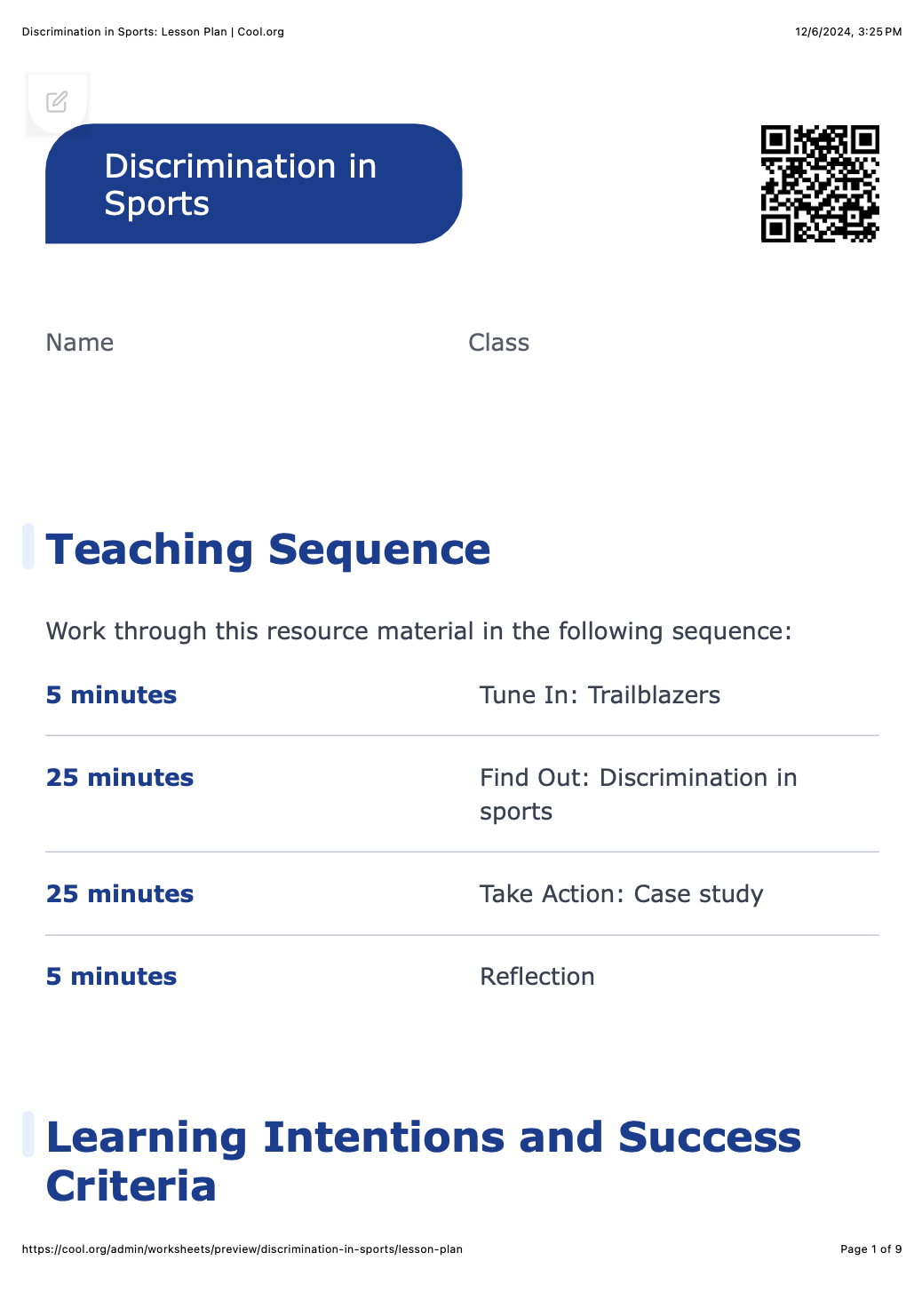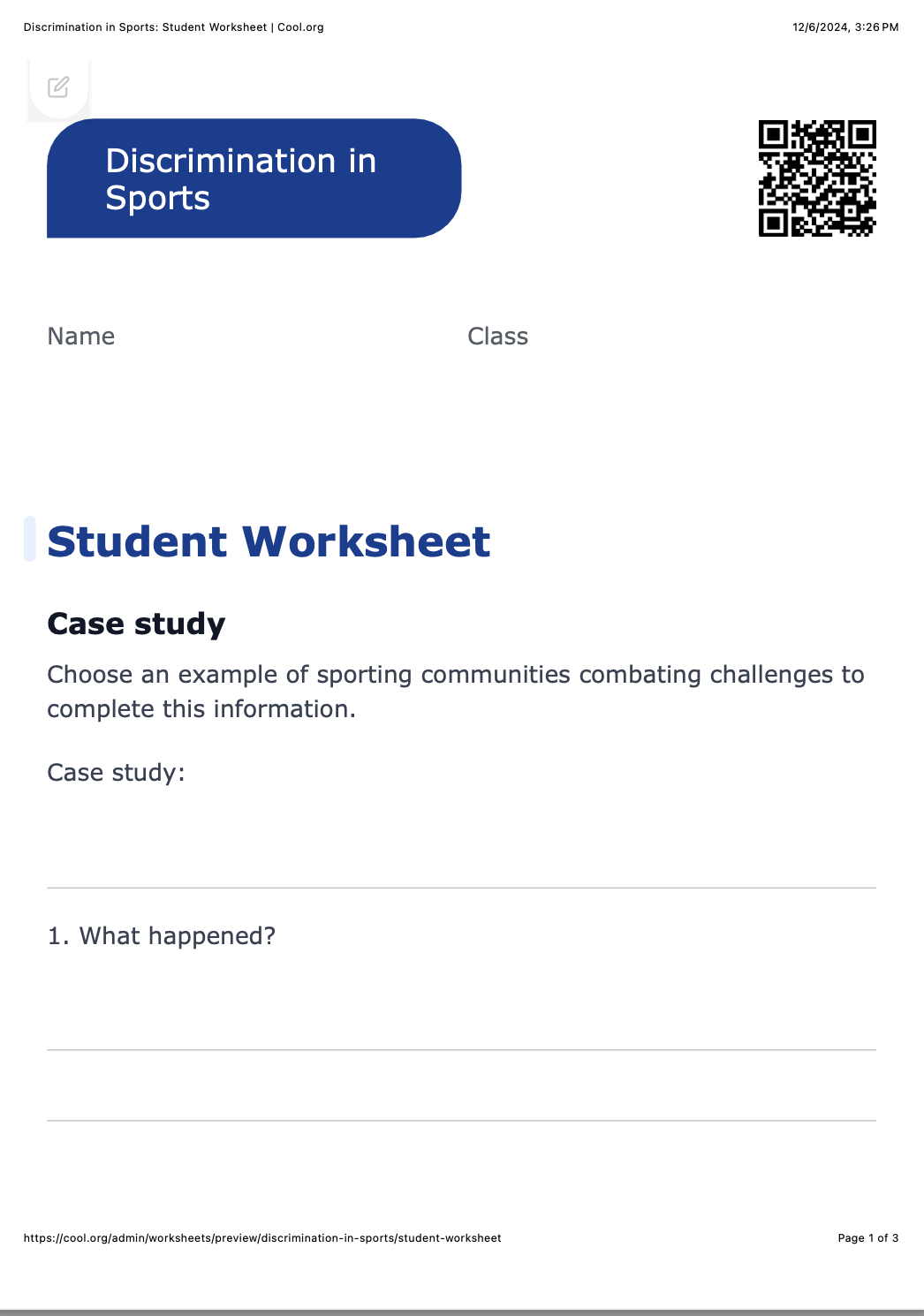Lesson summary
Students will discuss examples of discrimination faced by the Australian Women’s Football Team. They will explore case studies of sporting communities combating challenges. Students will research a specific case study and create a presentation about this example. This will include the concepts of coming together, community, allyship, etc.
Learning intentions:
Students will...
- explore examples of sporting communities coming together to achieve a goal.
Success criteria:
Students can...
- articulate some examples of the discrimination the women’s team faced
- share an example of sporting communities combating challenges.
Lesson guides and printables
Curriculum links
Select your curriculum from the options below.
Lesson details
Skills
This lesson is designed to build students’ competencies in the following skills:
- digital literacy
- empathy
- ethical understanding
- intercultural understanding
- reflection
Curriculum Mapping
Australian Curriculum (v9.0) content description:
Year 5, Humanities and Social Sciences (HASS)
- How citizens (members of communities) with shared beliefs and values work together to achieve a civic goal. (AC9HS5K07)
- Develop questions to investigate people, events, developments, places and systems. (AC9HS5S01)
- Locate, collect and organise information and data from primary and secondary sources in a range of formats. (AC9HS5S02)
General capabilities: Personal and Social Capability
NSW Curriculum:
- HT3-3 - Identifies change and continuity and describes the causes and effects of change on Australian society.
- HT3-4 - Describes and explains the struggles for rights and freedoms in Australia, including Aboriginal and Torres Strait Islander peoples.
Cross-curriculum priority: Aboriginal and Torres Strait Islander Histories and Cultures, Sustainability.
Relevant parts of Year 5 Humanities and Social Sciences (HASS) achievement standards:
- Students explain how people achieve civic goals.
- Students develop questions and locate, collect and organise information and data from primary and secondary sources.
Level of teacher scaffolding: Medium – facilitate class discussion and help students find appropriate resources.
UN Sustainable Development Goals
UN SDG 10: Reduce inequality within and among countries
- Target 10.2: By 2030, empower and promote the social, economic and political inclusion of all, irrespective of age, sex, disability, race, ethnicity, origin, religion or economic or other status
Resources Required
- Device to watch the ‘Trailblazers’ film if needed
- ‘Mind Map Brainstorming Sheet’ - for extension
- Resources to create a presentation such as poster sheets, computers, paper etc.
- Student devices for research.
- Student worksheet (1 per student)
Additional Info
Trailblazers is a Savage Films, Milestone Films, and LM Films production by Director/Producers Maggie Miles and Maggie Eudes and Producer Lucy Maclaren.
Trailblazers tells the story of the fight for equality by Australia’s female footballers. It celebrates the rise of Australian women’s football from the early days of paying-to-play in front of small crowds to appearing in sold-out stadiums, watched by over 11 million people at the 2023 FIFA Women’s World Cup.
The Cool.org resources and impact campaign are supported by major partner MECCA M-POWER and driven by Documentary Australia. The Trailblazers campaign aims to build momentum for further progress in gender equality and leadership and to increase investment and opportunities for women and girls to participate in sports.
If Trailblazers has inspired your students to take action, they can #Blaze a Trail for gender equality by take part in campaigns and sharing their commitment with the world.
Related Professional Learning
Creating an Inclusive Environment
Quick summary: This course focuses on creating an inclusive environment in education, highlighting the positive impact on academic outcomes and students' overall well-being. We will learn to define and establish an inclusive environment for students and their families. Tasks involve envisioning an ideal inclusive classroom, examining diversity legislation, reviewing school policies for inclusivity and analysing methods for accommodating diverse learning needs. Strategies covered include diverse material presentation, teaching styles, varied assessment methods, differentiation and inclusive language use, aiming to ensure equitable learning opportunities. The course encourages reflection on personal strategies and their implementation, setting goals for achieving an inclusive classroom. The conclusion emphasises the ongoing journey toward fostering inclusivity.



Welcome back!
Don't have an account yet?
Log in with:
Create your free Cool.org account.
Many of our resources are free, with an option to upgrade to Cool+ for premium content.
Already have an account?
Sign up with:
By signing up you accept Cool.org's Terms and Conditions(Opens in new tab) and Privacy Policy(Opens in new tab).